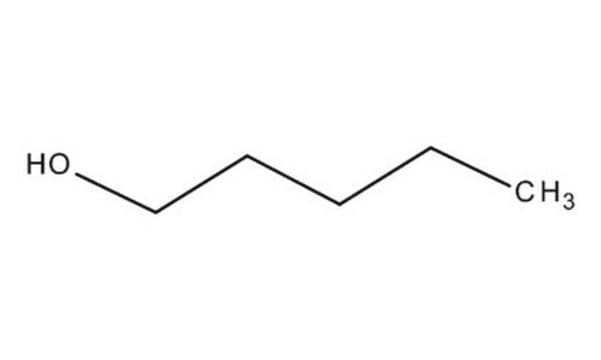W205605
1-Pentanol
≥99%, FG
Sinónimos:
1-Pentanol, n-Amyl alcohol, Pentyl alcohol
About This Item
Productos recomendados
biological source
synthetic
grade
FG
Fragrance grade
agency
follows IFRA guidelines
meets purity specifications of JECFA
reg. compliance
EU Regulation 1223/2009
EU Regulation 1334/2008 & 872/2012
FDA 21 CFR 172.515
FDA 21 CFR 176.180
FDA 21 CFR 176.210
vapor density
3 (vs air)
vapor pressure
1 mmHg ( 13.6 °C)
1.5 mmHg ( 20 °C)
assay
≥99%
form
liquid
autoignition temp.
572 °F
expl. lim.
10 %, 100 °F
refractive index
n20/D 1.409 (lit.)
bp
136-138 °C (lit.)
mp
−78 °C (lit.)
density
0.811 g/mL at 25 °C (lit.)
application(s)
flavors and fragrances
documentation
see Safety & Documentation for available documents
food allergen
no known allergens
fragrance allergen
no known allergens
organoleptic
pungent; chemical; wine-like
SMILES string
CCCCCO
InChI
1S/C5H12O/c1-2-3-4-5-6/h6H,2-5H2,1H3
InChI key
AMQJEAYHLZJPGS-UHFFFAOYSA-N
¿Está buscando productos similares? Visita Guía de comparación de productos
General description
Application
- Process-specified emission factors and characteristics of VOCs from the auto-repair painting industry.: This article evaluates the emission factors and characteristics of various volatile organic compounds, including amyl alcohol, in auto-repair painting, significant for environmental biochemistry and safety assessments (Xiao et al., 2024).
signalword
Danger
hcodes
Hazard Classifications
Acute Tox. 4 Inhalation - Eye Dam. 1 - Flam. Liq. 3 - Skin Irrit. 2 - STOT SE 3
target_organs
Respiratory system
Storage Class
3 - Flammable liquids
wgk_germany
WGK 1
flash_point_f
120.2 °F - closed cup
flash_point_c
49 °C - closed cup
ppe
Eyeshields, Faceshields, Gloves, type ABEK (EN14387) respirator filter
Certificados de análisis (COA)
Busque Certificados de análisis (COA) introduciendo el número de lote del producto. Los números de lote se encuentran en la etiqueta del producto después de las palabras «Lot» o «Batch»
¿Ya tiene este producto?
Encuentre la documentación para los productos que ha comprado recientemente en la Biblioteca de documentos.
Los clientes también vieron
Nuestro equipo de científicos tiene experiencia en todas las áreas de investigación: Ciencias de la vida, Ciencia de los materiales, Síntesis química, Cromatografía, Analítica y muchas otras.
Póngase en contacto con el Servicio técnico













